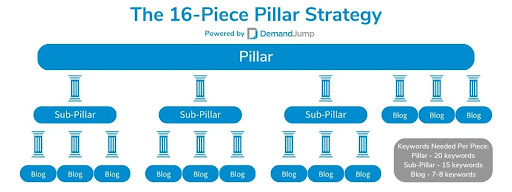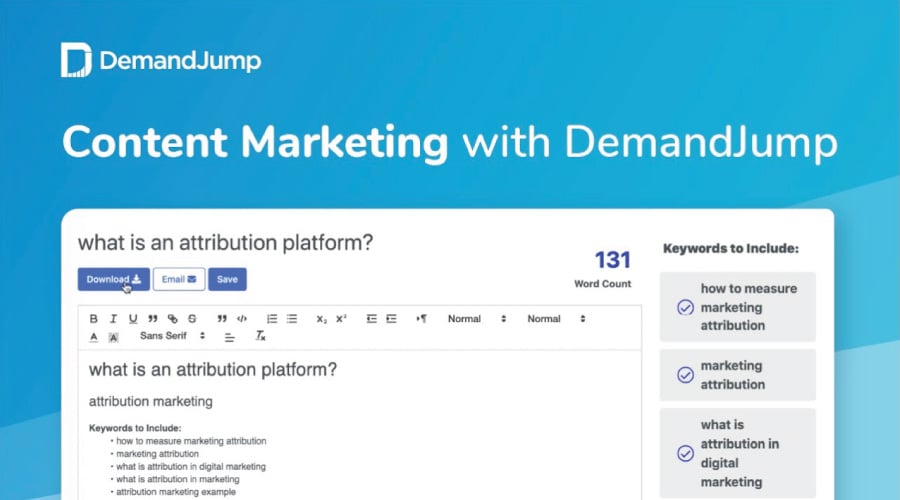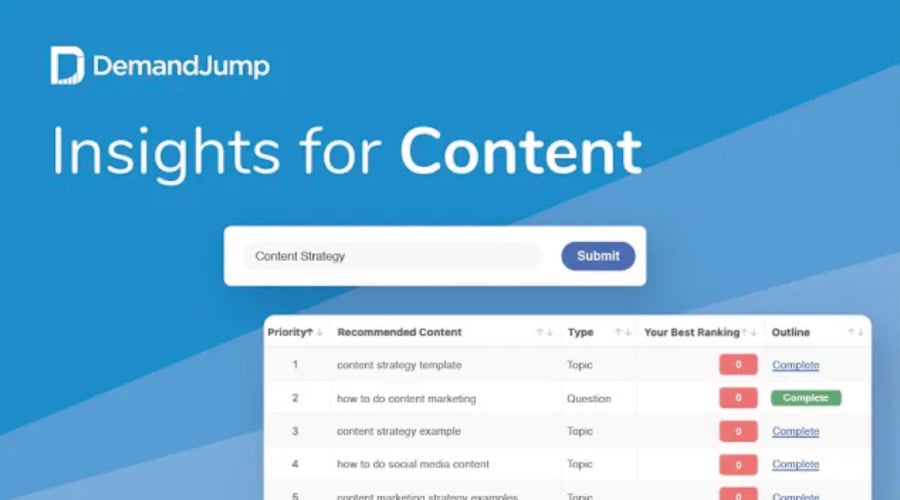If you’ve been involved in the marketing world at all, you probably have a pretty good sense of what search engine optimization (SEO) and SEO strategy are. However, SEO is tricky, and it’s easy to get stumped when we’re asked to put these things into action. Just think of when a child asks you to define a commonly used word—you know what it means, but when you have to actually describe it, sometimes you’re not really sure where to start. Because marketing practices are constantly evolving, having to implement even a simple SEO strategy can feel daunting.
We at DemandJump understand that it can be hard to keep up with marketing best practices sometimes. That’s why we’ve created this article to provide some clarity on some of the current SEO strategy trends. Before we get started, though, let’s cover a couple basic definitions to make sure all of us are on the same page. Don’t worry, we’ll sprinkle some examples throughout so that you can get a good grasp of each concept.
What Is SEO in Digital Marketing?
Search engine optimization (SEO) is the process of making your website and related content more discoverable by both search engines and your target audience. There are 4 types of SEO to help you in that process.
- On-Page SEO: You work on improving your discoverability by creating good content with keywords and internal links. You should also review old content to make sure the information you provided is still up-to-date and non-duplicative.
- Off-Page SEO: You help your target audience find your website by linking to it from other places, such as your social media pages and other companies’ websites.
- Technical SEO: You improve the navigation of your website for both search engines as well as human readers. Make sure your site map is organized, you don’t use the exact same content across pages, everything is mobile friendly, and load speeds are fast.
- Local SEO: You make it easier for those in your area to find your business. Using location-specific keywords in your content, as well as creating and regularly updating a Google Business Profile, will boost your discoverability.
It’s not enough to have a visually appealing website or high-quality content. Search engines need to be able to crawl and rank your content for your readers to find it. That’s why SEO tactics are such an important part of any marketing strategy.
Now that you have a clearer understanding of what SEO is, let’s take a look at a couple examples of SEO in digital marketing.

What Is an Example of SEO in Digital Marketing?
For the sake of our examples, let’s say that Jeanette is the head of marketing at a company called TechOn that provides cybersecurity Software as a Service (SaaS). TechOn has a lot to offer customers, but they’re still a fairly new company. Jeanette has been tasked with getting the word out about what her company has to offer. She does so through SEO best practices.
Jeanette starts with on-page SEO. She has a couple of writers create blog posts about cybersecurity for their website. Within each post, the writers use keywords that people often look up in search engines. They found these through DemandJump’s platform. They also link to other pages on their website that might provide more context about what they discuss in each blog, constructing an authority-building content network.
Once these blogs are posted, Jeanette logs onto TechOn’s social media pages to share them with the company’s followers. She also responds to comments on her posts and leaves her own comments (from TechOn’s page) on the posts of other companies in the same and related industries. While Jeanette is working on that, TechOn’s web designers are updating the code for the blog pages so that search engine crawlers can more easily scan and rank them in search engine results pages (SERPs).
After Jeanette has posted on social media, she reviews TechOn’s Google Business profile to make sure that it includes TechOn’s phone number and hours of operation in case any potential customer wants to reach out with questions.
While Jeanette can certainly do each of these actions separately, creating an SEO strategy is a great way for her to track progress toward goals and finish all tasks within a given timeframe.
What Is an SEO Strategy?
An SEO strategy is a plan that combines all those SEO best practices we’ve already talked about and includes a timeframe, goals, and responsibilities for different employees. When setting goals, make sure they are Specific, Measurable, Achievable, Relevant, and Timely (SMART). Your team can easily get discouraged when you set lofty goals without a great way to measure success or a timeframe to stick to. Goals that aren’t SMART make it harder to see progress on a project—and honestly don’t offer much guidance, either. With SMART goals, your team can easily take small steps to achieve something more significant.
You may also want to consider specifying which tools you plan on using throughout your process when creating SEO strategies of your own. DemandJump is a great one to have in your arsenal—but more on that later.
What Are the Main SEO Strategies?
The main SEO strategies prioritize creating and promoting helpful content. After all, the content is what drives most organic traffic to your website. Two of the main types of SEO strategy are Pillar-Based Marketing (PBM) and social media SEO. Let’s take a closer look at each of these.
Pillar-Based Marketing
A PBM strategy creates a content cluster centering on a specific topic to build brand authority and drive search engine results page (SERP) rankings. How? Through internal linking and the use of high-quality keywords that your target audience is searching for. Before we get into that, though, let’s start from the beginning.
Your company begins by choosing a topic relevant to your offerings or your industry. That topic will be the title of your Pillar—the 3,000-word article that the rest of your content in your strategy will link to. This piece should have about 20 keywords and provide a general overview of your topic. As a best practice, use long-tail keywords and questions as the headings in your piece and answer the question(s) right away to boost your chances of winning answer boxes in SERPs.
You’ll also write at least 3 Sub-Pillars—2,000-word articles with 15 keywords. These pieces will be a bit more specific than your Pillar and will link to your Pillar in the introduction. Finally, you’ll write 12 Supporting Blogs—750-word articles with 7-8 keywords. These are the most specific pieces of content within your strategy and answer the question in your title. Once written, 9 of these blogs will link to both the Pillar and relevant Sub-Pillar in the introduction. The other 3 will link only to the Pillar. You can see this framework laid out below:

This linking strategy establishes your company’s Pillar as an authoritative piece of content for that main topic. When you do that, you’ll see your content ranking on page one of search engine results for relevant keywords!
DemandJump’s platform makes creating a PBM strategy easy. Simply type in a concept you want to rank for, and our platform will generate potential topics for you to write about! Plus, our Content Briefs provide you with a list of keywords for each topic so you know which ones to include in each piece of content. Strategizing has never been easier!
Social Media SEO
Not only is social media a great place to promote your content, but you can also use it to spread brand awareness in general. If you want your target audience and social media algorithms to find and rank your pages higher on these platforms, start by using relevant keywords in your bio, handle, name, and/or posts—whatever you can do to get that SEO juice flowing!
You should also add subtitles and alt-text to any videos and images you share on your social media pages. It will not only ensure that those who are differently-abled can understand what the videos and images are, but that the social media algorithms can as well. The alt-text is another great place to include keywords so that these algorithms can place you higher in search results when users look up those terms. Browse through trending hashtags to see if any might be relevant enough to include in your posts.
What Is an Example of an SEO Strategy?
For an SEO strategy example, let’s continue with our fictitious company from above. We’ll say that Jeanette from TechOn creates a PBM strategy for cybersecurity risk assessment. These are a few examples of SEO keywords that Jeanette decides to use as titles for the pieces within this Pillar Strategy.
Pillar
Cybersecurity Risk Assessment
Sub-Pillars
Cybersecurity Risk Assessment Tools
Cybersecurity Risk Assessment Methodology
Cyber Risk Management Automation
Supporting Blogs
What Are the Different Types of Cybersecurity Assessments?
What Are Cybersecurity Assessment Tools?
What Is Included in a Cybersecurity Risk Assessment?
What Are Automated Risk Assessment Tools?
Jeanette assigns the writing team a couple of these pieces a week and sets a goal of having the entire strategy written in two months and all pieces edited and published in three months. When Jeanette publishes the pieces, she will do so all at once to build that authority for the Pillar quickly. She then promotes each piece of content through TechOn’s social media channels and encourages other employees to share them on their pages.
Finally, Jeanette uses DemandJump to track how well each piece of content is performing with the “My Content Performance” feature. She tracks keyword rankings using the “Keyword Rankings” feature.
What Makes a Good SEO Strategy?
A good SEO strategy is one that drives results and allows you to meet your marketing goals. To start developing your own, you will need to understand what your target audience is searching for and what search engines rank highly. Here are a few tips to keep in mind when creating an SEO strategy of your own:
- Your readers may not know as much as you do. Make sure you use language that they’ll understand in all your pieces of content. That doesn’t mean you have to “dumb down” your content. Simply avoiding jargon and spelling out any acronyms that your reader won’t know can go a long way.
- The importance of the user experience cannot be overstated. That means your website needs to look clean and organized. That also means that you need to create mobile-friendly content. After all, 86% of Americans get at least some of their news from their mobile devices. To create readable content on these devices, make sure to break up long chunks of text with headers, lists, images, and blank spaces.
- It’s okay—and encouraged—to change your strategy as necessary. You may start down one path only to realize that you’re not seeing the results you want. Go back to the drawing board and make some changes before you go any further.
- Don’t stuff your content with keywords. That doesn’t mean you can’t use keywords in your content. You need to include keywords so search engines understand what your content is about. However, stick too many in, and your reader will find your content more distracting than helpful. Search engines will penalize this practice, too.
- It’s okay to reuse keywords. Obviously, you don’t want to repeat titles of blogs in other pieces of content often, but it is okay to use the same keywords throughout your content. It further establishes your company as an authority for that particular keyword.

Another key to making a good SEO strategy? Using the right tools! DemandJump is one of the tools you should take advantage of when creating your own strategy.
How Do You Draft an SEO Strategy? With DemandJump!
DemandJump offers everything you need for the content part of your strategy, from creation to tracking results. Not only are we the only company so far that specializes specifically in Pillar-Based Marketing, but we’re the only one that also trains you in it. We are passionate about PBM, and we love getting our customers on board with it. Those who do see amazing results! If you’re ready to write your own SEO success story, start with DemandJump. Click the button below to try it for free.














